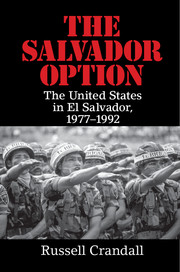Book contents
- Frontmatter
- Dedication
- Epigraph
- Contents
- List of Figures
- List of Organizations
- Acknowledgments
- 1 Introduction
- PART ONE EL SALVADOR IN THE COLD WAR
- PART TWO JIMMY CARTER
- PART THREE RONALD REAGAN
- 19 Reagan Arrives
- 20 Reagan and Salvador
- 21 El Mozote
- 22 Another Vietnam
- 23 Solidarity
- 24 Troop Cap and Certifying Human Rights
- 25 Reagan Gambles on Elections, 1982
- 26 The Shultz Doctrine
- 27 Human Rights
- 28 Henry Kissinger
- 29 Contras
- 30 “Elections Yes, Dialogue No,” 1984 Presidential Election
- 31 La Palma
- 32 Esquipulas
- 33 Counterinsurgency I
- 34 Counterinsurgency II
- 35 Zona Rosa
- 36 Air War
- 37 José Napoleón Duarte
- 38 Iran-Contra
- PART FOUR GEORGE H. W. BUSH
- PART FIVE POSTWAR
- Notes
- Bibliography
- Index
36 - Air War
from PART THREE - RONALD REAGAN
Published online by Cambridge University Press: 05 June 2016
- Frontmatter
- Dedication
- Epigraph
- Contents
- List of Figures
- List of Organizations
- Acknowledgments
- 1 Introduction
- PART ONE EL SALVADOR IN THE COLD WAR
- PART TWO JIMMY CARTER
- PART THREE RONALD REAGAN
- 19 Reagan Arrives
- 20 Reagan and Salvador
- 21 El Mozote
- 22 Another Vietnam
- 23 Solidarity
- 24 Troop Cap and Certifying Human Rights
- 25 Reagan Gambles on Elections, 1982
- 26 The Shultz Doctrine
- 27 Human Rights
- 28 Henry Kissinger
- 29 Contras
- 30 “Elections Yes, Dialogue No,” 1984 Presidential Election
- 31 La Palma
- 32 Esquipulas
- 33 Counterinsurgency I
- 34 Counterinsurgency II
- 35 Zona Rosa
- 36 Air War
- 37 José Napoleón Duarte
- 38 Iran-Contra
- PART FOUR GEORGE H. W. BUSH
- PART FIVE POSTWAR
- Notes
- Bibliography
- Index
Summary
I think what we're seeing in El Salvador today are some of the best guerrillas, probably the best guerrillas, we've seen in this hemisphere to date. They are certainly better than anything we saw in Nicaragua or Cuba.
– U.S. military advisor in El SalvadorWe are and will continue being friends of the people and governments of Cuba and Nicaragua, and it does not shame us. Completely to the contrary, we are proud to maintain relations with those people – bastions of the anti-imperialist struggle. The Reagan administration is not one to tell the FMLN who ought to be its friends and who its enemies.
– Radio Venceremos, March 1983In 1979, we thought it would be easier to take power. The intervention of the United States has changed the circumstances.
– Mario López, FMLN leader, 1984“Just as It Did in Southeast Asia”
Following the series of successful elections – and in particular the ascension of José Napoleón Duarte to the presidency – U.S. policy toward El Salvador became less controversial back in Washington. But in the mid-1980s, a disagreement broke out as to whether American aid and training were making the war worse. This referred to the so-called air war that critics alleged the Salvadoran Air Force was waging against civilians in FMLN-controlled areas. One critic received international attention when he described the air war as “indiscriminate attacks” on “defenseless civilians,” a war being waged by the Salvadoran military against villages “suspected of being sympathetic” to the guerrillas. “Just as it did in Southeast Asia, terror from the air has created vast numbers of refugees in El Salvador.”
The air war quickly turned from a military tactic to a political controversy. Solidarity groups opposed to the U.S.-backed Duarte government and their allies on Capitol Hill were focusing on the issue. Here is how one critic described the scorched-earth strategy in a letter to the New York Times:
A secret air war is taking place in El Salvador. In U.S.-supplied aircraft, Salvadoran pilots drop 500- and 750-pound antipersonnel bombs, as well as napalm and U.S.-supplied white phosphorus on the civilian population in the countryside.…The Catholic Archdiocese in San Salvador says U.S.-supplied AC-47 gunships – the most powerful weaponry in Central America –are in use against civilians.
- Type
- Chapter
- Information
- The Salvador OptionThe United States in El Salvador, 1977–1992, pp. 377 - 381Publisher: Cambridge University PressPrint publication year: 2016

